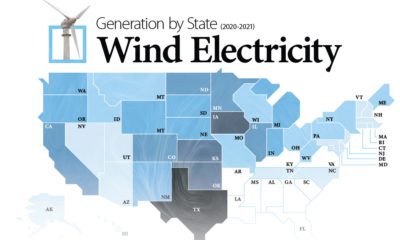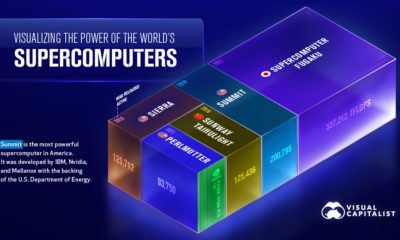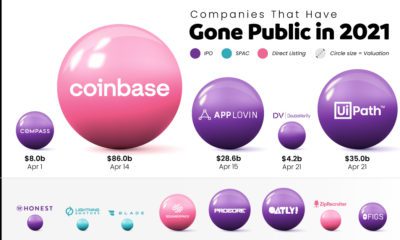Mining has traditionally been depicted with pack mules, pickaxes, and rugged prospectors. However, it may surprise you to learn that today’s mining industry is precisely the opposite in almost every respect. It’s high-tech, efficient, and safe. This is partially because modern mining companies are deploying the latest in sensor and cloud technology. These connected mines are improving the extraction process and workers’ safety while also boosting productivity. Today’s infographic comes to us from Natural Resources Canada and discusses how this sensor and cloud technology can be integrated into the extractive process.
What is Smart Mining?
A connected mine uses data from sensor technology to effectively manage underground and pit mining operations. – Mukani Moyo, McKinsey Senior Expert (Source) From a single application on a mobile device, supervisors at mine sites can now receive alerts via SMS, email or in-app notifications. This helps them react to critical problems in real-time and maximize productivity. In addition, advanced data analytics can be applied to the raw data to create insights, visualizations, and recommendations. This information is delivered to mine managers and employees in real-time on their mobile devices.
Case Study: Smart Solutions in Practice
Dundee Precious Metals was one of the first companies to bring wireless networks into an underground mine. The company used RFID and Wi-Fi to monitor the location of equipment and people. The networks also allowed personnel to stay connected to the surface.
Once the networks were installed, communication was reliable and instantaneous – even almost 2,000 feet underground at the bottom of the mine. Workers could bring laptops and smartphones into the mine to stay connected to personnel and software on the surface.
With an RFID chip on every vehicle, machine, and person, managers can see the location of everyone and everything in the mine. This helps prevent accidents and breakdowns, and streamlines operations in real-time.
There are also environmental and cost-saving benefits. Using location data, an automated ventilation system can respond and minimize energy consumption.
Fans turn on and off as miners enter or leave an area. In addition, fan speeds adjust when machines or vehicles are running nearby to ensure that emissions are properly vented. This could drastically reduce a mine’s energy requirements.
Changing the Nature of Work: Remote Working
These smart mining solutions are reducing the risks miners face and creating new opportunities for a tech-savvy generation.
Remote mine locations that revolve around shift work can place stress on workers and their families. With a connected infrastructure, mine employees and managers can monitor operations at a distant office.
There will always be a need for workers on site, but connected technology can create some town-based career opportunities and help stabilize families.
A Sustainable Future for Mining
This is just the beginning.
Over time, data from sensor technology and cloud software, will reveal insights that could help develop sustainable mining operations.
By minimizing their negative impacts, mining companies will be able to responsibly deliver the materials the modern world needs.
on
Both figures surpassed analyst expectations by a wide margin, and in January, the unemployment rate hit a 53-year low of 3.4%. With the recent release of February’s numbers, unemployment is now reported at a slightly higher 3.6%.
A low unemployment rate is a classic sign of a strong economy. However, as this visualization shows, unemployment often reaches a cyclical low point right before a recession materializes.
Reasons for the Trend
In an interview regarding the January jobs data, U.S. Treasury Secretary Janet Yellen made a bold statement: While there’s nothing wrong with this assessment, the trend we’ve highlighted suggests that Yellen may need to backtrack in the near future. So why do recessions tend to begin after unemployment bottoms out?
The Economic Cycle
The economic cycle refers to the economy’s natural tendency to fluctuate between periods of growth and recession. This can be thought of similarly to the four seasons in a year. An economy expands (spring), reaches a peak (summer), begins to contract (fall), then hits a trough (winter). With this in mind, it’s reasonable to assume that a cyclical low in the unemployment rate (peak employment) is simply a sign that the economy has reached a high point.
Monetary Policy
During periods of low unemployment, employers may have a harder time finding workers. This forces them to offer higher wages, which can contribute to inflation. For context, consider the labor shortage that emerged following the COVID-19 pandemic. We can see that U.S. wage growth (represented by a three-month moving average) has climbed substantially, and has held above 6% since March 2022. The Federal Reserve, whose mandate is to ensure price stability, will take measures to prevent inflation from climbing too far. In practice, this involves raising interest rates, which makes borrowing more expensive and dampens economic activity. Companies are less likely to expand, reducing investment and cutting jobs. Consumers, on the other hand, reduce the amount of large purchases they make. Because of these reactions, some believe that aggressive rate hikes by the Fed can either cause a recession, or make them worse. This is supported by recent research, which found that since 1950, central banks have been unable to slow inflation without a recession occurring shortly after.
Politicians Clash With Economists
The Fed has raised interest rates at an unprecedented pace since March 2022 to combat high inflation. More recently, Fed Chairman Jerome Powell warned that interest rates could be raised even higher than originally expected if inflation continues above target. Senator Elizabeth Warren expressed concern that this would cost Americans their jobs, and ultimately, cause a recession. Powell remains committed to bringing down inflation, but with the recent failures of Silicon Valley Bank and Signature Bank, some analysts believe there could be a pause coming in interest rate hikes. Editor’s note: just after publication of this article, it was confirmed that U.S. interest rates were hiked by 25 basis points (bps) by the Federal Reserve.












